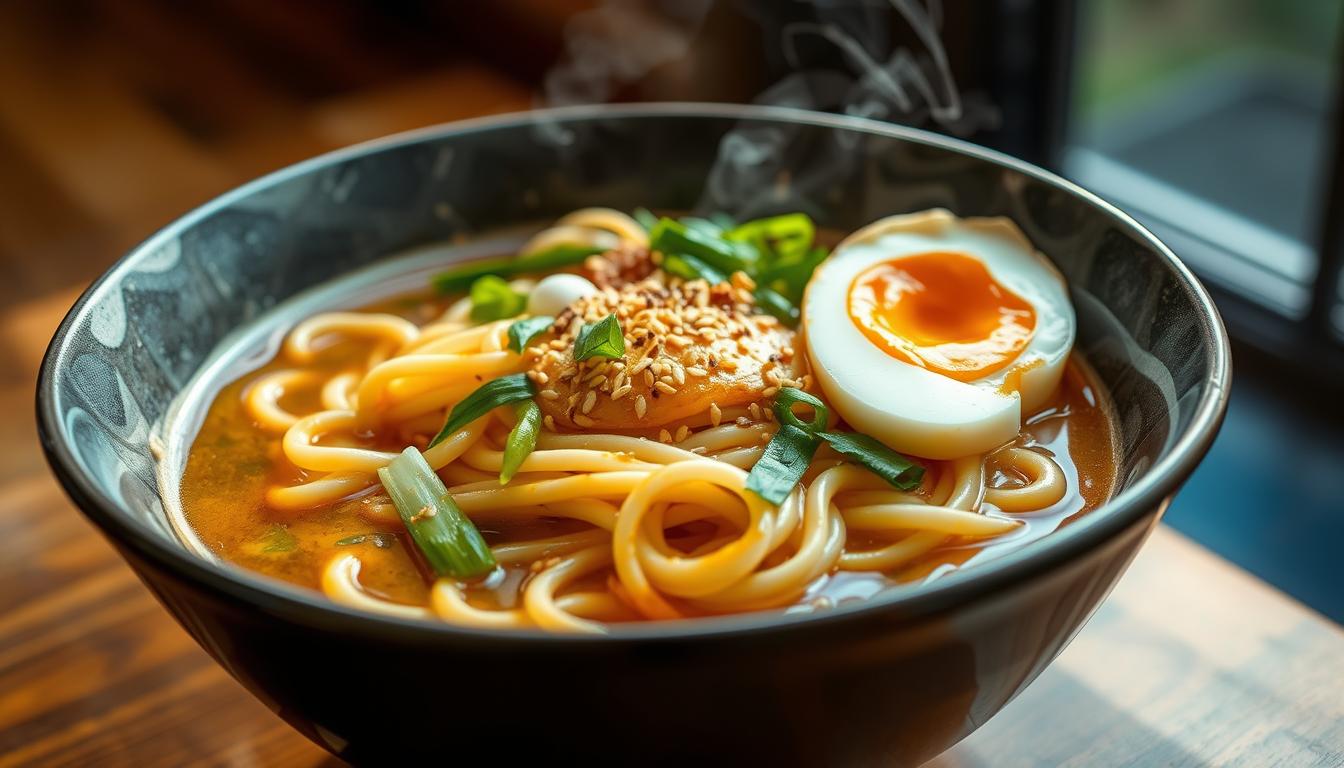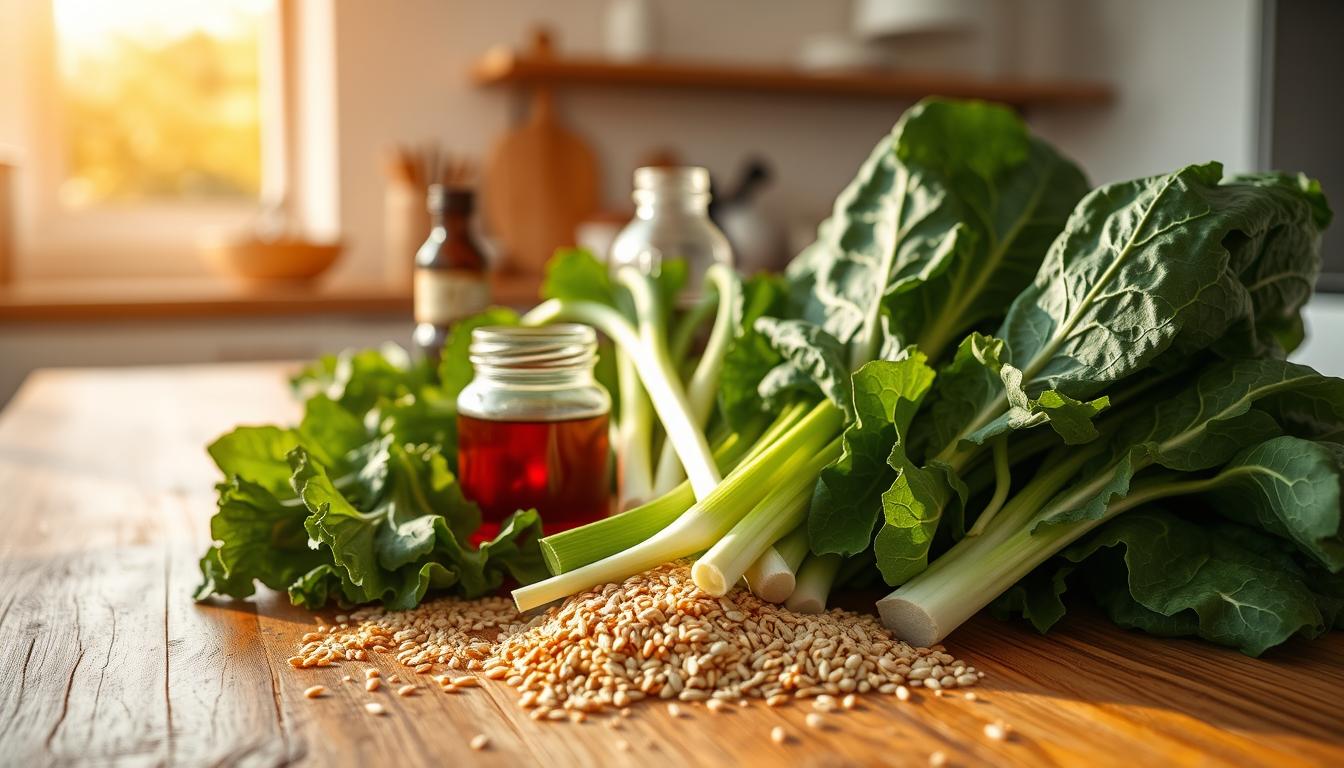Delicious Vegan Sesame Ramen Recipe You'll Love!

Remember that moment when a dish changed your cooking world? For me, it was vegan sesame ramen. This plant-based dish surprised me with its rich flavors and satisfying texture. It made me rethink vegetarian food.
Getting into vegan sesame ramen is a fun food adventure. This recipe is more than just a meal. It's a celebration of creative plant-based cooking that's full of flavor. It's perfect for vegans and anyone looking to try new tastes.
Imagine making a top-notch ramen at home. It's a dish that's full of nutrients, umami, and no animal products. The key is using the right ingredients and techniques. They turn simple parts into a memorable meal.
Key Takeaways
- Discover a mouthwatering vegan sesame ramen recipe
- Learn how plant-based cooking can be incredibly flavorful
- Explore innovative meat-free culinary techniques
- Create restaurant-quality meals at home
- Understand the versatility of vegan ingredients
The Rise of Plant-Based Ramen: A Modern Twist on Japanese Tradition
Ramen has changed a lot in recent years. Vegan-friendly ramen restaurants are making this classic Japanese dish new again. The world of food is seeing a big change as plant-based options get better and tastier.

Ramen used to be all about meat, but now it's all about plant-based recipes. Chefs are exploring new ways to make delicious, meat-free ramen. They're making plant-based ramen that's just as good as the traditional kind.
Culinary Innovation in Plant-Based Ramen
Modern vegan-friendly ramen places are finding new ways to make food taste great without animal products. They're using:
- Mushroom-based umami concentrates
- Fermented vegetable broths
- Seaweed and miso flavor enhancers
- Roasted vegetable reduction techniques
Nutritional Advantages of Plant-Based Ramen
Choosing vegetarian ramen broth is good for your health. It usually has:
- Less saturated fat
- More fiber
- A wider range of nutrients
- More antioxidants
"Plant-based ramen isn't just a trend—it's a culinary revolution that respects both health and flavor." - Chef Naomi Yasuda
Plant-based ramen is more than just a food choice. It's a celebration of creativity, caring for the planet, and the changing world of food.
Essential Ingredients for Perfect Vegan Sesame Ramen Recipe

Starting a vegan sesame ramen recipe means picking the right ingredients. This journey to a tasty plant-based meal begins with knowing the key parts. These parts make the dish truly special.
Sesame oil flavors are the heart of this recipe. They add depth and richness to your ramen. Choose a high-quality, cold-pressed sesame oil. It should have a strong nutty aroma and complex taste.
- Noodle BaseOrganic ramen noodles
- Wheat-free alternatives (rice or buckwheat noodles)
- Gluten-free options
- Essential Sesame IngredientsToasted sesame oil
- Raw sesame seeds
- Black sesame paste
- Flavor EnhancersTamari or soy sauce
- Miso paste
- Rice vinegar
When picking ingredients for your vegan sesame ramen, choose fresh and high-quality ones. Opt for organic, non-GMO products. They offer better nutrition and flavor.
Pro tip: Always taste your sesame oil before using. A high-quality oil should have a rich, nutty aroma without any bitter undertones.
Your local Asian grocery store or specialty market will have the best ingredients. Feel free to try different sesame oil flavors. Find the perfect mix for you.
Crafting the Ultimate Vegetarian Ramen Broth
Making a great vegetarian ramen broth takes skill and love. It's all about mastering plant-based cooking. A top-notch vegetarian ramen broth can turn a simple meal into a feast.
The key to a fantastic vegetarian ramen broth is layering flavors and picking the best ingredients. You aim to create a depth of taste that rivals meat-based broths.
Building Deep Umami Flavors
To get intense umami in your vegetarian ramen broth, choose the right ingredients. Important ones include:
- Dried kombu seaweed
- Shiitake mushrooms
- Roasted garlic
- Soy sauce
- Miso paste
Selecting the Right Mushrooms and Aromatics
Mushrooms are key to a rich vegetarian ramen broth. Shiitake and porcini mushrooms add a meaty flavor that boosts your broth.
Mastering Sesame Oil Proportions
Sesame oil is crucial for your vegetarian ramen broth. Use toasted sesame oil carefully - a little is enough. Start with 1-2 teaspoons per quart, adjusting to taste. You want a nutty, rich flavor that complements other ingredients.
Pro tip: Toast your sesame seeds before adding oil to intensify the flavor profile of your vegetarian ramen broth.
Choosing the Best Noodles for Your Plant-Based Bowl
Choosing the right noodles is crucial for your plant-based noodle dish. Ramen lovers know noodles are the dish's heart, making vegan sesame ramen special.
When picking noodles, consider a few things. The noodles should match your broth, cook well, and feel right in your mouth.
- Wheat-based traditional ramen noodles
- Gluten-free alternatives like rice or buckwheat noodles
- Whole grain options for added nutrition
- Fresh versus dried noodle varieties
For those wanting real flavor, think about these noodle traits:
- Thickness: Thin noodles soak up broth fast
- Texture: Firm noodles stay firm in hot liquid
- Cooking time: Fresh noodles cook quicker than dried ones
Top picks for your dish include organic wheat noodles, soba noodles, and rice noodles. Each adds something special to your vegan sesame ramen, making it a memorable meal.
"The right noodle transforms a simple meal into a gourmet adventure." - Ramen Experts
Pro tip: Always taste-test your noodles while cooking. This ensures they're perfectly al dente, making your dish amazing.
Protein-Rich Meat Alternatives for Your Ramen
Discovering delicious vegan protein sources can make your ramen a nutritious meal. Plant-based meat alternatives for ramen add exciting textures and flavors. They satisfy even the most discerning food lovers.
Your ramen doesn't have to lose out on protein or taste with these amazing plant-based options. Vegan protein sources offer the same satisfying experience as traditional meat.
Tofu and Tempeh: Versatile Protein Powerhouses
Tofu and tempeh are top meat alternatives for ramen. They bring unique qualities to your bowl:
- Tofu: Absorbs flavors beautifully when marinated
- Tempeh: Offers a firmer, nuttier texture
- Both provide complete protein profiles
Exploring Other Plant Protein Options
Beyond tofu and tempeh, many vegan protein sources can enhance your ramen:
- Seitan: Wheat-based protein with meat-like consistency
- Textured Vegetable Protein (TVP): Quick-cooking and versatile
- Soy curls: Tender and easy to season
By trying these protein alternatives, you'll make a ramen bowl that's both nutritious and delicious.
Creative Dairy-Free Toppings and Garnishes
Turning your vegan sesame ramen into a masterpiece is more than just the broth and noodles. The right dairy-free toppings can make a big difference. They add texture, flavor, and make your dish look amazing.
Here are some exciting dairy-free ramen toppings to try:
- Crispy Roasted Vegetables: Char-roasted brussels sprouts, crispy mushrooms, and caramelized carrots
- Crunchy Seed Medley: Toasted pumpkin seeds, sunflower seeds, and black sesame seeds
- Fresh Herb Garnishes: Chopped cilantro, green onions, and Thai basil
- Plant-Based Protein Additions: Crispy baked tofu cubes and marinated tempeh strips
Texture is key when choosing dairy-free ramen toppings. Mix soft and crunchy elements for a fun eating experience. Adding pickled vegetables like radish or kimchi gives a tangy twist to your dish.
"Great ramen is about balance - every topping should tell a story on your plate." - Chef Keiko Tanaka
For a deeper umami flavor, try nori flakes, nutritional yeast, or roasted seaweed strips. These toppings add rich taste without using dairy.
Tips for Achieving Restaurant-Quality Results at Home
Making vegan-friendly ramen at home can be as good as what top restaurants offer. Professional chefs say perfect ramen needs careful technique and detail.
To make your kitchen a gourmet ramen space, learn key skills. Your aim is to match restaurant quality with precision and creativity.
Professional Plating Techniques
Presentation is as important as taste. Here are expert plating tips:
- Use white or neutral-colored bowls to show off your ramen's colors
- Make height by placing toppings smartly
- Decorate with fresh herbs for looks
- Drizzle sesame oil in a creative way
Temperature and Timing Considerations
Getting the perfect ramen needs exact temperature control:
- Serve broth very hot (around 180-190°F)
- Keep noodles al dente by cooking as instructed
- Prepare toppings just before serving for best texture
- Use a kitchen thermometer for consistent results
Pro tip: Mise en place is key. Prepare all ingredients before cooking to make your process smooth and ensure top-notch results.
Storing and Reheating Your Vegan Ramen
Keeping your vegan sesame ramen fresh is key. You need to store and reheat it right. This way, your meal stays delicious and safe to eat.
When you store your vegan sesame ramen, keep things separate. This helps keep the flavors and textures just right. Here are some important tips:
- Store broth and noodles in separate airtight containers
- Keep toppings in individual sealed containers
- Refrigerate components within 2 hours of cooking
- Consume stored ramen within 3-4 days
Reheating your vegan sesame ramen needs care. Never microwave noodles directly in the broth. This can make them mushy and lose their texture.
For the best reheating results:
- Warm the broth separately in a pot on low heat
- Briefly dip noodles in hot water to restore their texture
- Reheat toppings individually to prevent overcooking
- Combine components just before serving
Don't throw away leftover vegan sesame ramen. You can turn the broth into a stir-fry sauce. Or, use leftover noodles in a cold sesame noodle salad.
Conclusion
Exploring this vegan sesame ramen recipe opens up a world of tasty plant-based noodle dishes. Your kitchen becomes a place where traditional Japanese food meets today's dietary needs. Each bowl is more than a meal; it's a celebration of creative cooking and mindful eating.
This vegan sesame ramen recipe is very flexible. You can try different ingredients, change the spice levels, and make it your own. You can pick your favorite protein and vegetables, making each meal unique to you.
Choosing plant-based meals has a big impact. By making dishes like this vegan sesame ramen, you help the environment and support better food production. Your food choices show you care about the planet and global health.
As you keep trying new plant-based recipes, remember every meal is a chance to learn. Share your ramen recipes with friends, post about your cooking, and encourage others to try vegan food. Your journey with this sesame ramen recipe is just the start of a tasty, kind food adventure.
FAQ
Can I make this vegan sesame ramen recipe gluten-free?
Yes, you can make it gluten-free. Use gluten-free noodles like rice, sweet potato, or buckwheat. Make sure your soy sauce is tamari or gluten-free. Also, check that all ingredients are gluten-free.
How long can I store homemade vegan ramen broth?
Store it in an airtight container in the fridge for 4-5 days. Freeze it for up to 3 months. Cool it down first and leave space for expansion.
What are the best protein alternatives for vegan ramen?
Great options include crispy tofu, marinated tempeh, and seitan strips. Roasted edamame is also good. TVP and chickpeas add protein too.
How can I make the ramen broth more flavorful?
Use kombu, shiitake mushrooms, and miso paste for flavor. Roasting veggies and using quality sesame oil helps. Ginger and garlic add depth.
Are there any nut-free options for this recipe?
Yes, skip nut toppings and use soy or oat milk. Sunflower seeds are a nut-free crunch option. Always check labels for nuts.
How can I make the ramen spicier?
Add sriracha, chili oil, or gochujang paste for heat. Start with a little and adjust. Togarashi spice adds a spicy flavor.
What are some budget-friendly protein options for vegan ramen?
Affordable options are firm tofu, chickpeas, TVP, and frozen edamame. They're nutritious and easy to season.



0 Comments